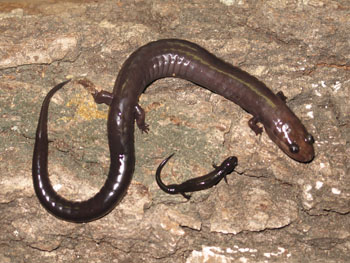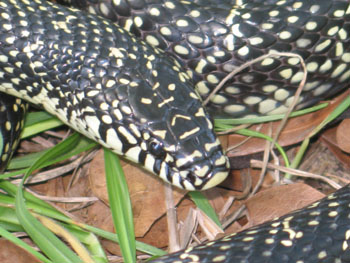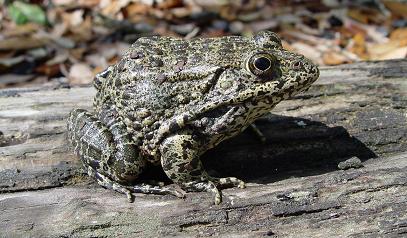 |
Alabama Chapter of Partners in
 Amphibian and Reptile Conservation
Amphibian and Reptile Conservation
 |
 |
Click here to go to species list
Click here to read more about Alabama's Herpetological Diversity
 |
|
Phaeognathus
hubrichti
|
A trip from the cold rivers of the Alabama Cumberland Plateau—where hellbenders hide under huge flat rocks—to the Mobile Delta—where the Alabama redbelly cooter grazes on brackish-water plants—would take you through one of the most spectacular herpetological faunas in the world. Be sure to stop along the way at Mount Cheaha, and you may find a wood frog hopping across the road on the way to a ditch to breed, so long as you plan your trip for the dead of winter on a miserable rainy night. Instead, perhaps plan your field trip during the first hint of spring, and each log or rock turned might present a pink-orange spring salamander, the tiny and ancient seepage salamander, and handfuls of webster’s salamanders in yellow or red. Once you cross into the coastal plain, try a beaver pond and some new vernal pools after a warm spring rain, and enjoy choruses of banjo, bull, and leopard frogs, spring peepers and upland chorus frogs, fowler’s and southern toads, northern and southern cricket frogs, and green, barking, pine woods, bird-voiced, and gray treefrogs—all calling at once! Do some snorkeling in one of our big rivers, and you might find black-knobbed, Alabama, and common map turtles in the same five mile stretch, with a chance for a big gator snapper or a flattened musk turtle in some spots. Don’t miss your chance to scan a moist beech-magnolia slope in the Red Hills, and if it’s your lucky day you may see the purple face of a Phaeognathus smiling muppetly at you, waiting for a cricket. A glass lizard is a good possibility out on the coast, and some folks even find pine woods snakes out there, near beaches where female loggerheads haul themselves out on occasion.
 |
|
Lampropeltis
getula
|
For its size, the state of Alabama has one of the richest herpetofaunas in North America. Alabama has four state endemic species (Alabama redbelly cooter, black warrior waterdog, flattened musk turtle, and Red Hills salamander), more than any other southeastern state. Alabama also has more turtle species than any state in the union. Biogeographical factors seem to contribute to this astounding diversity: Alabama has a great blend of physiographic regions which intersect in the middle of the state, with Coastal Plain-associated species (for example, the gopher tortoise) abundant in the south, and montane forms (for example, the wood frog) reaching their southern limits in the northern part of the state. Alabama has also enjoyed climatic stability for many of the past million-odd years, so our state has been a refuge for many odd and ancient species during past ecological fluctuations. Finally, our diversity of large, ancient, and unique river drainages (Tennessee, Alabama, and Apalachicola) often have their own separate faunal assemblages.
So grab you headlamps and herping gear and get on out there. Due to Alabama’s mild climate and herp diversity, you can go herping any time—spring, summer, fall...even in the middle of winter!
Visit our parent organizations:
© 2009-2012 Alabama Partners in Amphibian and Reptile
Conservation
This website and any products posted herein are officially
recognized by the national entity,
Partners in Amphibian and Reptile Conservation (PARC), as the
efforts of an approved PARC state chapter.


